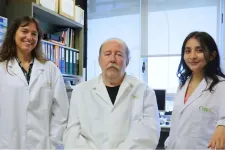(Press-News.org) A new, Earth-sized planet orbiting an ultra-cool red dwarf star, has been detected by an international team of astronomers – just 55 light years away.
The planet is only the second of its kind to be discovered around this type of star. Called SPECULOOS-3 b, it takes around 17 hours to complete an orbit of the star which is more than twice as cold as our sun, as well as ten times less massive and a hundred times less luminous.
Days and nights on SPECULOOS-3 b seem to be endless: the planet is likely to be tidally locked, so the same side – the ‘dayside’ – always faces the star in a relationship similar to our moon and Earth.
The discovery, published today (15 May 2024) in Nature Astronomy, was made by the SPECULOOS project, which is led by the University of Liège, in Belgium, in collaboration with the Universities of Birmingham, Cambridge, Bern, and the Massachusetts Institute of Technology. SPECULOOS (Search for Planets EClipsing ULtra-cOOl Stars) was established to search for exoplanets orbiting ultra-cool dwarf stars using a network of robotic telescopes based around the world.
Ultra-cool dwarf stars are extremely common, making up around 70% of the stars in the Milky Way. But they are also very faint and scattered across the sky, so scientists have to observe data from telescopes over several weeks, monitoring each star individually to detect transiting planets.
“We designed SPECULOOS specifically to observe nearby ultracool dwarf stars in search of rocky planets that lend themselves well to detailed studies," says Michaël Gillon, astronomer at the University of Liège and lead author on the paper. "In 2017, our SPECULOOS prototype using the TRAPPIST telescope discovered the famous TRAPPIST-1 system made up of seven Earth-sized planets, several of them potentially habitable. This was an excellent start!”
Whilst most observations of this discovery were made by SPECULOOS telescopes in the Northern Hemisphere, the University of Birmingham researchers contributed some observations taken at the SPECULOOS South Observatory, located in the Atacama Desert in Chile.
Amaury Triaud, Professor of Exoplanetology at the University of Birmingham said: “The discovery of SPECULOOS-3 shows our worldwide network functions well and is ready to detect yet more rocky worlds orbiting very low mass stars While ultra-cool dwarf stars are cooler and smaller than our sun, their lifespan is over a hundred times longer – around 100 billion years – and they are expected to be the last stars still shining in the Universe.”
This long life span, scientists believe, could offer opportunities for life on orbiting planets to develop.
Whilst most astronomical data is automatically analysed and planetary candidates are often first detected by algorithms before being reviewed by humans, in this case, this did not happen. Members of the SPECULOOS team had taken the habit to quickly glance at the nightly data when they became available, and Dr Georgina Dransfield, a former PhD student at the University of Birmingham and a current postdoctoral researcher in Birmingham noticed the planetary signal and alerted the whole collaboration.
She said: “The small size of ultra-cool dwarfs makes it easier to detect small planets. SPECULOOS-3b is special in that its stellar and planetary properties make it an optimal target for JWST, which is capable to get information about the composition of the rocks that make its surface.”
Next steps for the project could include follow-up observations by the James Webb Space Telescope, which would deliver important insights into the planet’s surface mineralogy, and the potential for an atmosphere.
END
Astronomers discover new Earth-sized world orbiting an ultra-cool star
2024-05-15
ELSE PRESS RELEASES FROM THIS DATE:
New biomarker to diagnose Alzheimer's in asymptomatic stages
2024-05-15
A recent study led by the Molecular and Cellular Neurobiotechnology group at the Institute for Bioengineering of Catalonia (IBEC) and the University of Barcelona has identified a new biomarker for Alzheimer's disease in asymptomatic stages of the disease. The molecule is miR-519a-3p, a microRNA directly linked to the expression of the cellular prion protein (PrPC), which is deregulated in people suffering from some neurodegenerative diseases such as Alzheimer's.
The search for biomarkers that are stable and easily detectable in biofluids, ...
Research sheds light on how proteins linked to Alzheimer’s disease influence neuronal growth
2024-05-15
New research has shed light in the complex interplay between cell proteins, and how they impact on neurons in neurodevelopmental disorders and Alzheimer’s disease.
A new study led by the University of Exeter and published in Royal Society Open Biology has discovered the key role that the protein Contactin-4 (encoded by the gene CNTN4) plays in shaping neurons.
The researchers began studying CNTN4 because it was known to have a role in autism, but its functional roles were not well understood. The team explored how CNTN4 functions within the brain, particularly its interactions with proteins involved in neurodegenerative diseases like Alzheimer's ...
Early retirement of old vehicles won't save the planet: A study
2024-05-15
Lifespan caps for passenger vehicles have limited effect on reducing greenhouse gas emissions and could drive up costs and material use finds a new study published in Environmental Research: Infrastructure and Sustainability. The research shows that although Light-Duty vehicles (LDVs) contribute 17% to the annual greenhouse gas emissions in the United States, imposing a 15-year lifespan cap on LDV fleets under a business-as-usual scenario will not lead to any meaningful reductions in GHG emissions.
To combat delayed uptake of Electric Vehicles (EVs), some have argued for limits on the vehicle’s ...
EuroPCR 2024 – Short-term data from NOTION-2: TAVR versus SAVI for younger patients with aortic stenosis
2024-05-15
Paris, France, 14-17 May 2024. The Course Directors have selected 3 major Late Breaking Trials (LBTs) that will be presented for the first time during the 2024 edition of EuroPCR. These trials were selected on account of their design, outcomes and potential to influence daily clinical practice. Among them is the NOTION-2 randomised clinical trial (RCT).
Background
Evidence comparing the use of transcatheter aortic valve implantation (TAVI) and surgical aortic valve replacement (SAVR) in low-risk patients with aortic ...
EuroPCR 2024 – One-month DAPT followed by 5-month Ticagrelor monotherapy in acute coronary syndromes with DCB - results from REC-CAGEFREE II
2024-05-15
Paris, France, 14-17 May 2024. The Course Directors have selected 3 major Late Breaking Trials (LBTs) that will be presented for the first time during the 2024 edition of EuroPCR. These trials were selected on account of their design, outcomes and potential to influence daily clinical practice. Among them is the REC-CAGEFREE II trial.
Background and methods
The REC-CAGEFREE II trial is an open-label, investigator-initiated, non-inferiority, multicentre randomised trial comparing stepwise de-escalation of dual antiplatelet therapy (DAPT) with standard DAPT in patients with acute coronary syndrome (ACS) treated with paclitaxel-coated balloons (PCB). Eligible ...
EuroPCR 2024 – Early outcomes of a randomised non-inferiority trial comparing TAVI devices: the LANDMARK trial
2024-05-15
Paris, France, 14-17 May 2024. The Course Directors have selected 3 major Late Breaking Trials (LBTs) that will be presented for the first time during the 2024 edition of EuroPCR. These trials were selected on account of their design, outcomes and potential to influence daily clinical practice. Among them is the LANDMARK trial.
Background and Methods
Key randomized controlled trials have compared surgical aortic valve replacement (SAVR) with transcatheter aortic valve implantation (TAVI) using one of two commercially available transcatheter heart valves (THVs) - ...
How does exercise benefit the brain?
2024-05-15
New research published in Aging Cell provides insights into how exercise may help to prevent or slow cognitive decline during aging.
For the study, investigators assessed the expression of genes in individual cells in the brains of mice. The team found that exercise has a significant impact on gene expression in microglia, the immune cells of the central nervous system that support brain function. Specifically, the group found that exercise reverts the gene expression patterns of aged microglia to patterns seen in young microglia.
Treatments that depleted ...
How will climate change affect the distribution of jellyfish and other gelatinous zooplankton in the Arctic Ocean?
2024-05-15
Gelatinous zooplankton, including jellyfish and other diverse, nearly transparent organisms, play important roles in marine ecosystems. Climate change is expected to significantly alter their populations and distributions. New research published in Limnology and Oceanography examines their fate in the Arctic Ocean, one of the fastest warming oceans on Earth.
Investigators coupled three-dimensional species distribution models with oceanographic variables from the Coupled Model Intercomparison Project Phase 6. The analyses allowed the team to identify gelatinous ...
Researchers identify new marker for breast cancer prognosis
2024-05-15
A protein called retinitis pigmentosa GTPase regulator interacting protein 1-like (RPGRIP1L) performs various functions that are important for development and for health throughout life, and mutations in the RPGRIP1L gene have been linked to different diseases. New research published in The FASEB Journal indicates that expression levels of the RPGRIP1L gene might serve as a new prognostic marker for individuals with invasive breast cancer.
When investigators examined breast tissue specimens from different women, they found that the ...
Can robot-inspired computer-assisted therapy benefit children with autism?
2024-05-15
A new study published in the Journal of Computer Assisted Learning introduces a novel Robot-Inspired Computer-Assisted Adaptive Autism Therapy (RoboCA3T) that leverages the natural affinity of children with autism spectrum disorder towards technology and robots.
RoboCA3T harnesses the potential of robot-assisted therapies by incorporating robot avatars and integrating them with computer-assisted therapies through a web-based solution.
When investigators assessed Childhood Autism Rating Scale scores before and after the intervention, ...

